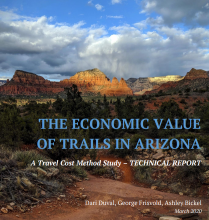The Economic Value of Trails in Arizona - A Travel Cost Method Study

Outdoor recreation supports the quality of life and health of individuals, communities, and local economies. Trail access for non-motorized and motorized recreation enriches the lives of community residents and visitors, providing an outlet for exercise, outdoor recreation, and transportation. The inherent value and enjoyment derived from outdoor recreation is not directly monetized, for example, through consumer spending or property values, yet it is the driver behind the outdoor recreation economy. The economic value that individuals place on amenities like trails can be measured in terms of consumer surplus. Consumer surplus is a monetary measure of how well-off individuals are as a result of consuming or using a particular good, service, or resource.In other words, it estimates the value of a good based on the benefits that individuals derive from using the good, service, or resource. For goods that are not bought and sold in markets, such as natural amenities, the value of a particular resource can be estimated indirectly using what is known as the travel cost method. In this method, benefits of an amenity are estimated based on how much individuals spend in time and money to travel to enjoy a particular amenity.
Estimating the economic value associated with use of natural resources and amenities is important in understanding how society is impacted by changes in the quality of or access to those resources. It can help to guide public policy and investments by informing our understanding of the benefits and costs of different actions affecting natural resources and amenities valued by the public.
As a complement to the Arizona State Parks 2020 Trails Plan, this study estimates the economic value of non-motorized and motorized trail use to Arizona residents using the travel cost method. Trail use includes use of trails managed by Arizona State Parks, the National Park Service, the U.S. Forest Service, the Bureau of Land Management, and other land management agencies for both non-motorized and motorized uses. Non-motorized uses include walking, hiking, mountain biking,and horseback riding/equestrian use,among others. Motorized trail uses include dirt biking, ATV, UTV, side-by-side, and four wheeling, among others. In addition to the economic value of trail use in Arizona to in-state residents, we also estimate total annual trail use for both non-motorized and motorized recreation, presenting the results in an origin-destination matrix that captures the estimated flow of in-state travel between counties for non-motorized and motorized trail recreation.Finally, we examine the importance of trail amenities to Arizona residents in their decisions of where to live and where to travel for leisure, both with important implications for community development.

